Breakthrough technology development to decarbonize steelmaking processes
Technical Issues for realizing a carbon-neutral production process
In nature, iron exists as oxidized iron ore. To produce steel products, oxygen must be removed (= reduced) from iron ore. This reduction process has been carried out by the blast furnace (BF) and the basic oxygen furnace (BOF), using carbon such as coal.
In this process, coal (coke) is 1) a reducing agent, 2) a source of heat, and 3) plays a role to support the function of raw materials at high temperature in a solid form while facilitating to maintain ventilation in the furnace. Although the coal (coke) has been utilized in a continuous, efficient steelmaking from iron ore, CO2 is inevitably generated during the reduction reaction.
We are therefore drastically reviewing this process and plans to reduce CO2 emissions by replacing coal (coke) as a reducing agent with hydrogen to produce H2O instead of carbon in the reduction.
However, as reduction with hydrogen is an endothermic reaction, the temperature drop in the furnace causes problems such as the reaction not being sustained and the iron not melting. In order to realize hydrogen steelmaking, we are tackling these problems by development of breakthrough technologies such as 1) high-temperature heating of flammable hydrogen, 2) securing of gas flow in the furnace, 3) additional melting process, and 4) large-scale production for production.
*If you are viewing this document on a smartphone, enlarge the figure and use it.
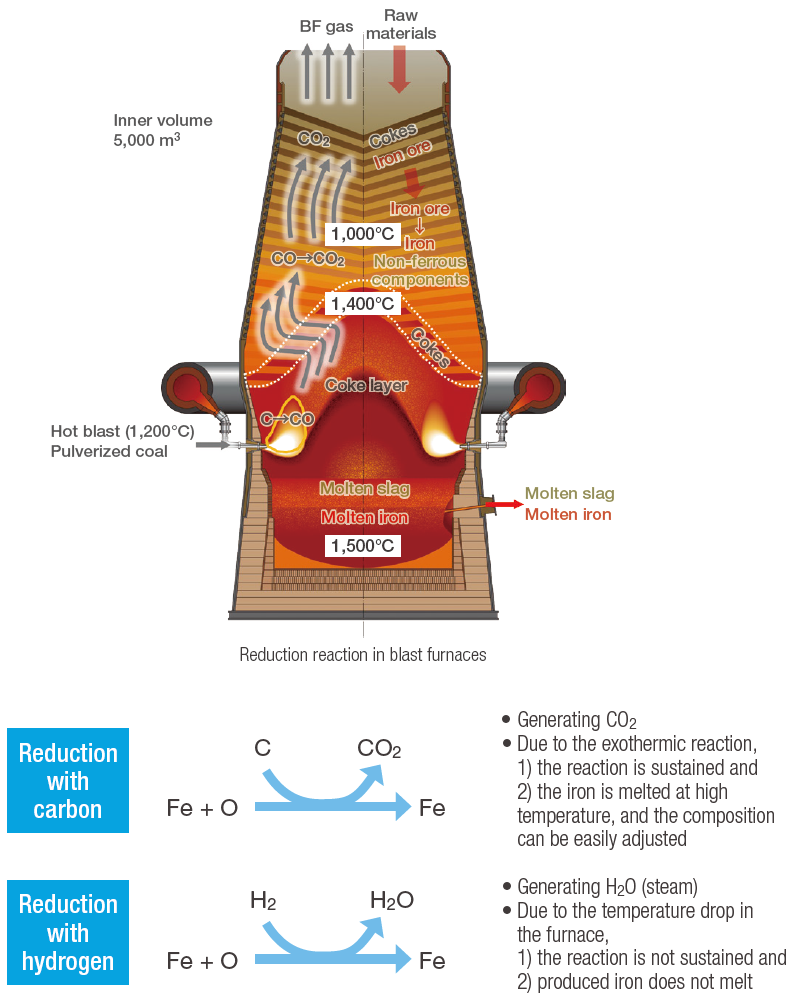
Reduction with carbon vs. hydrogen
Challenge of developing breakthrough technologies
(1)Reduction with hydrogen in blast furnaces
Concerning “Reduction with hydrogen in BFs,” Japan’s three blast furnace steelmakers, including Nippon Steel, are jointly developing the COURSE50 blast furnace, designed to replace carbon used in the BF as a reducing agent with hydrogen-rich gases generated in steelworks. This project has already established the technologies that can reduce CO2 emission in a COURSE50 test furnace (12m3).
In February 2023, we decided to conduct demonstration tests at the East Nippon Works Kimitsu Area using the No. 2 BF, a large-scale BF in operation that is approximately 400 times larger than the test furnace. We are installing equipment for the demonstration tests, which are scheduled to begin in fiscal 2026. Since May 2022, we have been developing technologies with the modified COURSE50 test furnace. So far, the test in November-December 2023 has already confirmed the world’s highest 33% reduction in CO2 emission in the blast furnace. We are conducting more demonstration tests to further reduce CO2 emissions by 40% or more.
We are working to establish the Super COURSE50 technology in large BFs (50% or more reduction in CO2 emissions).
*If you are viewing this document on a smartphone, enlarge the figure and use it.
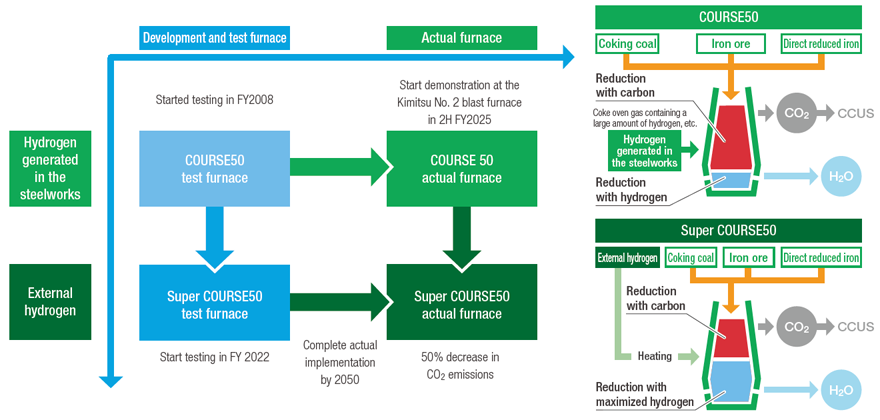
Click here for details on the “Green Innovation Fund Project/Hydrogen Utilization Project in Steel Making Process” https://www.greins.jp/en/
The COURSE50 Project1, The Super COURSE50 Project2
The COURSE50 is a technology development project that was undertaken from 2008 to 2022 with the aim of partially realizing steel production using hydrogen in the current situation where there is no infrastructure for supplying large amounts of hydrogen.
In the 12m3 test blast furnace constructed in the Kimitsu Area of East Nippon Works, the testing has a target of about a 30% reduction in CO2 emissions: more than 10% by hydrogen reduction using hydrogen contained in the hydrogen-based by-product gas (coke oven gas) generated in the steelworks, and a 20% offset through separation and capture of CO2 from the blast furnace gas. The testing verified more than 10% by hydrogen reduction while, in the case of offset by CO2 capture, we have developed an energy-saving technology using the chemical absorption method and have already put it into practical use for the industrial use of CO2.
Looking ahead to a time when the social infrastructure for an adequate hydrogen supply is in place, we are undertaking the Super COURSE50, a development project aided by the GI Fund with a technology aimed at further reduction of CO2 emissions (more than 50% reduction) by heating and using hydrogen purchased from outside the steelworks, and by maintaining the thermal balance inside the blast furnace.
The testing began in May 2022, and the project has steadily advanced development, confirming the world’s highest-level reduction of 22% in CO2 emissions from the blast furnace itself.
The subsequent testing in November and December 2023 confirmed a 33% reduction in CO2 emissions from the blast furnace itself, posting a new record for the highest reduction in the world. We are proceeding with verification testing with the goal of reducing emissions by 40% or more in fiscal 2024.
1Commissioned project by the New Energy and Industrial Technology Development Organization (NEDO)
2The Green Innovation Fund “Hydrogen utilization in iron and steelmaking processes” project (NEDO’s R&D outsourcing support and assistance project)
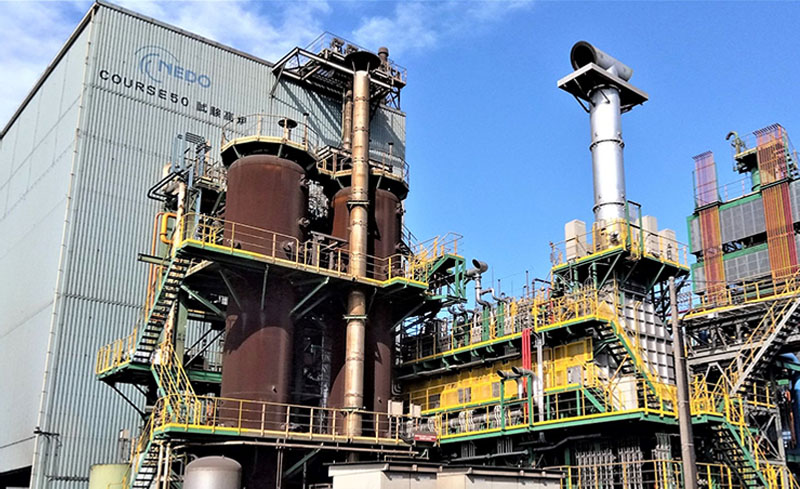
Source: NEDO “Hydrogen utilization in iron and steelmaking processes” project
(2)High-grade steel production in large-sized EAFs
Concerning “High-grade steel production in large size EAF,” a new EAF installed in the Setouchi Works Hirohata Area started its commercial operation in October 2022, making it the world’s first integrated EAF steelmaking process that enables the production and supply of high-grade electrical steel sheets.
Also, regarding the conversion from the BF-BOF process to the EAF process, we started full-scale studies at two candidate sites, the Kyushu Works Yawata Area and the Setouchi Works Hirohata Area.
We began construction of a small EAF (capacity: 10 tons) in the Hasaki R&D Center to start experiments in the second half of fiscal 2024.
*If you are viewing this document on a smartphone, enlarge the figure and use it.

(3)100% hydrogen use in direct reduction process
In the 100% hydrogen use in direct reduction, we try zero CO2 emissions in reduction process by fully using hydrogen as the reducing agent. Since this process produces solid direct reduced iron (DRI), it is necessary to melt it and separate out its gangue component (the material present together with ore) in the subsequent process such as in the blast furnace (BF) or EAF.
Most of the actual direct reduction methods currently use high-grade iron ore, which is not easily broken or sticked to each other, during the reduction process. As the high-grade one is limited to about 10% of iron ore available in the market, we will challenge to use lower-grade iron ore in the process. Current DRI process uses methane (natural gas) as the reducing agent. Methane contains carbon and hence emits CO2. We try 100% use of hydrogen as the reducing agent in the direct reduction process. The process, however, has its own high technical issues, too. Since the reduction process with hydrogen is an endothermic reaction, it is necessary to supply heat to maintain the reaction. In addition, in the case of using a shaft furnace, powdering of the raw material pellets, and sticking of produced iron pellets are the problems to be solved.
we started building a small test furnace in the Hasaki R&D Center to start experiments in fiscal 2025. In order to realize production efficiency that can replace the blast furnace process by using the integrated process of hydrogen direct reduction, electric melting furnace, and converter for low-grade iron ore, we are also starting to develop a technology for high efficiency melting by electric melting furnace utilizing direct reduced iron.
Based on this, by 2040, we aim to solve issues such as utilization of low-grade iron ore and conversion of reduction material from natural gas to hydrogen, and we aim to establish technology for commercializing a direct hydrogen reduction reactor using lowgrade iron ore from Australia and other countries as feedstock.
*If you are viewing this document on a smartphone, enlarge the figure and use it.

Efforts toward stable procurement of hydrogen
Nippon Steel has a strong interest in hydrogen from a variety of perspectives, including the fact that we have the potential to become one of Japan’s leading hydrogen users in the future (we estimate that the amount of hydrogen needed to be carbon neutral at our company will exceed 7 million tons per year), the need to realize a lower hydrogen price than other industries need3, and that we are a major supplier of steel for hydrogen infrastructure.
We therefore participate in various hydrogen-related councils promoted by the Ministry of Economy, Trade and Industry and the Energy Agency, as well as the cross-sectional network that includes hydrogen-related industries such as energy, automobiles, and chemicals, and various organizations. We are also mindful of working with the system design, not only for Nippon Steel but for the entire steel industry, when needed.
Concerning the overseas procurement of hydrogen, we are considering cooperation with overseas resource majors, who may potentially supply hydrogen to us. We are thus active on a wide and widening front.
3 Target hydrogen cost of ¥20/Nm3 or less in the METI’s “Green Growth Strategy through Achieving Carbon Neutrality in 2050,” compared to the current hydrogen cost equivalent to coking coal of approx. ¥8/Nm3.
Efforts to reduce carbon emission in power generation
We generate 89% of the electricity we use at our steelworks, 70% of which is from internally generated energy sources such as waste heat and by-product gases. We also use LNG, petroleum, and coal as externalsource auxiliary fuels. Therefore, in order to reduce the carbon content of our electric power structure, we will examine and promote the following efforts:
Issues to consider and promote reducing carbon in the electric power structure
- Total elimination of inefficient coal-fired power
- Increase efficiency in thermal power fired by by-products, utilization of CCUS, and use of non-fossil fuels for external auxiliary fuels (expanded use of zero-emission fuels such as biomass, ammonia, and hydrogen)
- Purchase of green power
CCUS technology development
CCUS (Carbon Capture, Utilization and Storage) is a technology that separates, captures, and stores CO2 in the ground, or directly uses CO2 or converts it into other materials and utilizes it. In the carbon neutral steel production process, CCUS technology is used to process CO2 still generated from the steelmaking process even after it has been minimized. Realization of this technology requires the related technology development as well as preparation of external conditions. The required technologies include development and installment of CO2 separation and recovery technology (high-performance chemical absorption liquid) and development of CO2–based manufacturing technologies for chemicals and fuels. The necessary external conditions include the securing of the storage space, the establishment of the storage infrastructure for CCS, legislation, and tax incentives, the ensuring of business profitability of chemicals and fuels manufactured by CCU (Carbon Capture and Utilization), and preferential treatment of carbon recycled products. The Nippon Steel Group is aggressively engaged in developing these technologies to help realize social implementation of CCUS.
Click here for details on “Advanced CCS Support Project by JOGMEC” https://www.jogmec.go.jp/english/ccs/index.html
Nippon Steel Group’s CCUS technology development efforts
Capture
CO2 Separation and Recovery Technology
(NEDO COURSE50 Project)
Nippon Steel Engineering Co. in the Nippon Steel Group has commercialized an energy-saving CO2 chemical absorption process called ESCAP™(Energy Saving CO2 Absorption Process), which uses chemical absorption, one of the methods for CO2 separation and recovery. Two units are already in operation in Japan, including the one installed in the North Nippon Works Muroran Area.
The ESCAP™ is characterized by high energy efficiency with a more than 40% reduction in heat consumption compared to general-purpose technology. In addition, its proprietary impurity removal facility enables recovery of more than 99.9% of high-purity CO2 from raw material gas with high impurities.
*If you are viewing this document on a smartphone, enlarge the figure and use it.
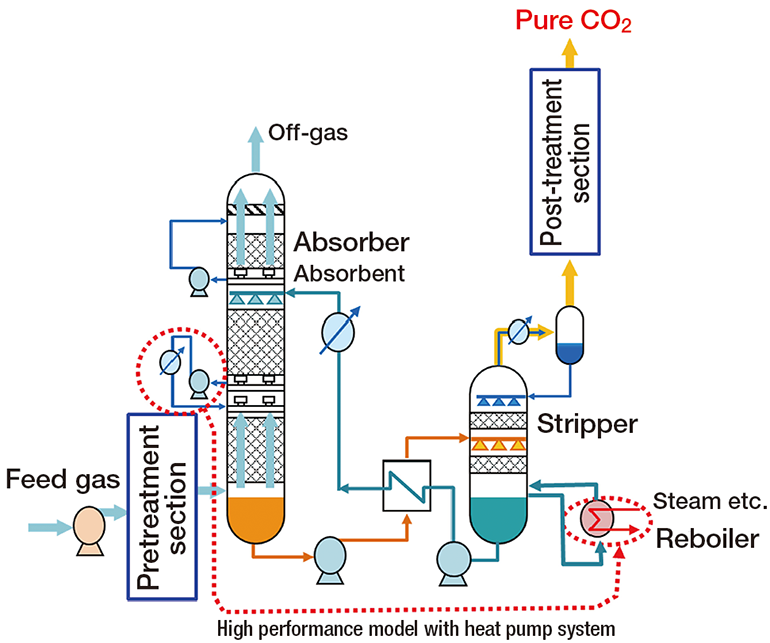
Flowsheet of ESCAP™
Development of low–concentration CO2 separation and capture technology (subsidized by the Green Innovation Fund)
Nippon Steel, in collaboration with Oita University, Osaka University, Kyoto University, Chiba University, Nagoya University, Hokkaido University, and Resonac Corporation, started the full-scale development of separation/capture technology for low-concentration CO2 contained in industrial emission gases.
To separate/capture CO2 efficiently from low-pressure, low concentration emission gases (with a CO2 concentration of 10% or less at the atmospheric pressure), we are working on the development and social implementation of a new CO2 separating agent (structurally flexible PCP), which has higher CO2 selectivity and enables CO2 adsorption and desorption with minimal levels of pressure operation.
*If you are viewing this document on a smartphone, enlarge the figure and use it.
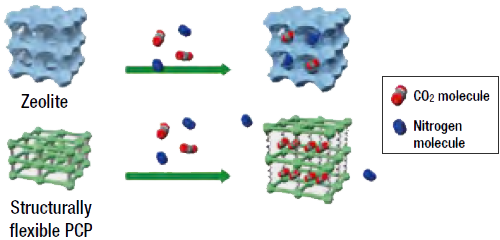
Transportation
Integrated CO2 ship transportation (NEDO–commissioned project)
Jointly with Japan CCS Co., Engineering Advancement Association of Japan, and ITOCHU Corporation, and Nippon Gas Line, we have commenced the R&D and demonstration project related to a CO2 transport vessel.
Storage
CO2 storage technologies
As part of the Survey on the Implementation of Japan Advanced CCS Projects that the Japan Organization for Metals and Energy Security (JOGMEC) adopted for its publicly solicited projects in fiscal 2023, Nippon Steel participates in three joint projects: the Tohoku Region West Coast CCS Project, the Metropolitan Area CCS Project, and the Oceania CCS Project.
In this project, we will work jointly with each participating company to secure storage sites, develop storage infrastructure, and establish external conditions such as developing regulatory requirements. At the same time, we will take the initiative in studies related to CO2 separation/ capture, liquefaction, and shipping terminals, actively promoting the early social implementation of CCS infrastructure.
*If you are viewing this document on a smartphone, enlarge the figure and use it.
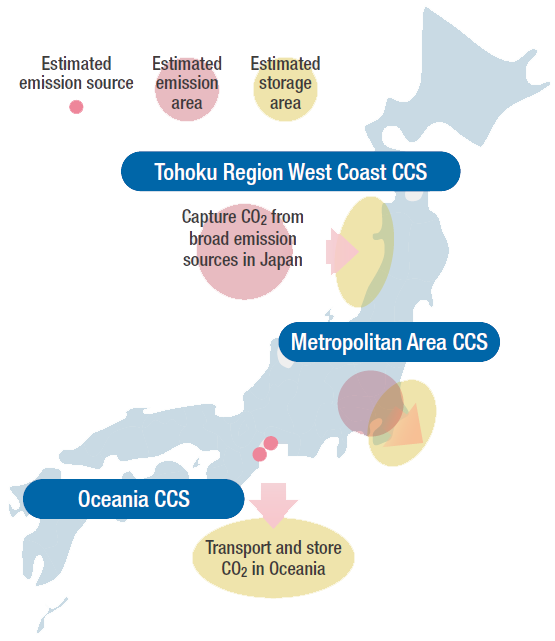
Utilization
Chemical product manufacturing technology using CO2 as a raw material (project commissioned by NEDO)
In April 2023, Nippon Steel, Osaka Metropolitan University, Kyoto University, Tohoku University, Tokyo University, and UBE Corporation started research and development on the “development of one-step synthesis process for polycarbonate diol from CO2.” Polycarbonate diol is a representative material for producing high value-added carbon compounds that do not require hydrogen. It is also a raw material for high-performance polyurethanes, widely used worldwide and whose demand is expected to grow further. However, the high environmental impact of its synthesis process has been a major issue. In contrast, this research and development aims to develop an innovative green process that effectively utilizes CO2 instead of highly toxic gases such as CO and achieves high yields in one-step synthesis.
*If you are viewing this document on a smartphone, enlarge the figure and use it.
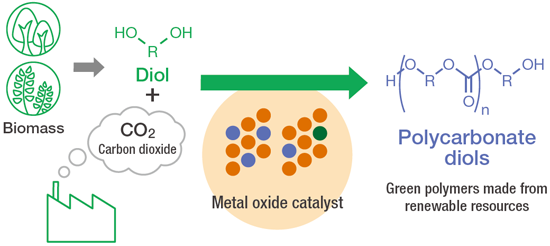
Absorption and fixation by marine life
(subsidized as the NEDO Project)
Develop and commercialize technology to create seaweed beds (blue carbon ecosystem) by using fertilizers made of steel slag, a by-product of steelmaking, in coastal areas.
*If you are viewing this document on a smartphone, enlarge the figure and use it.
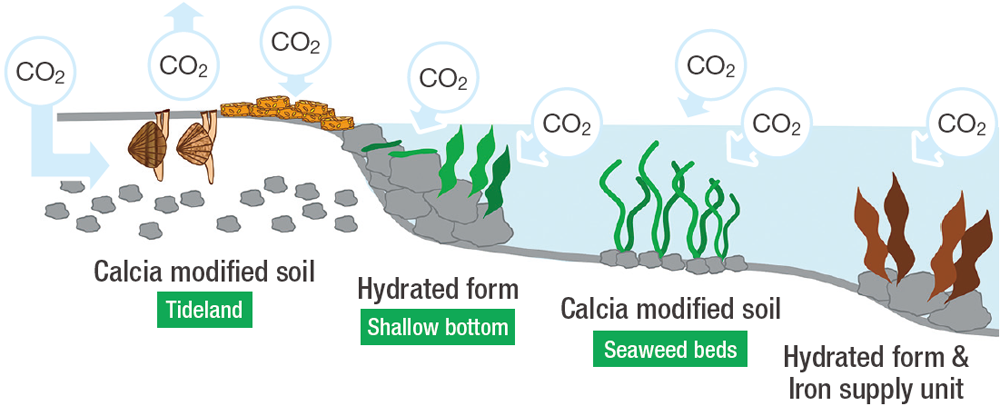
Our development and technological prowess
R&D staff (non-consol.) 800
atents (non-consol.) Japan15,000 Overseas18,000
